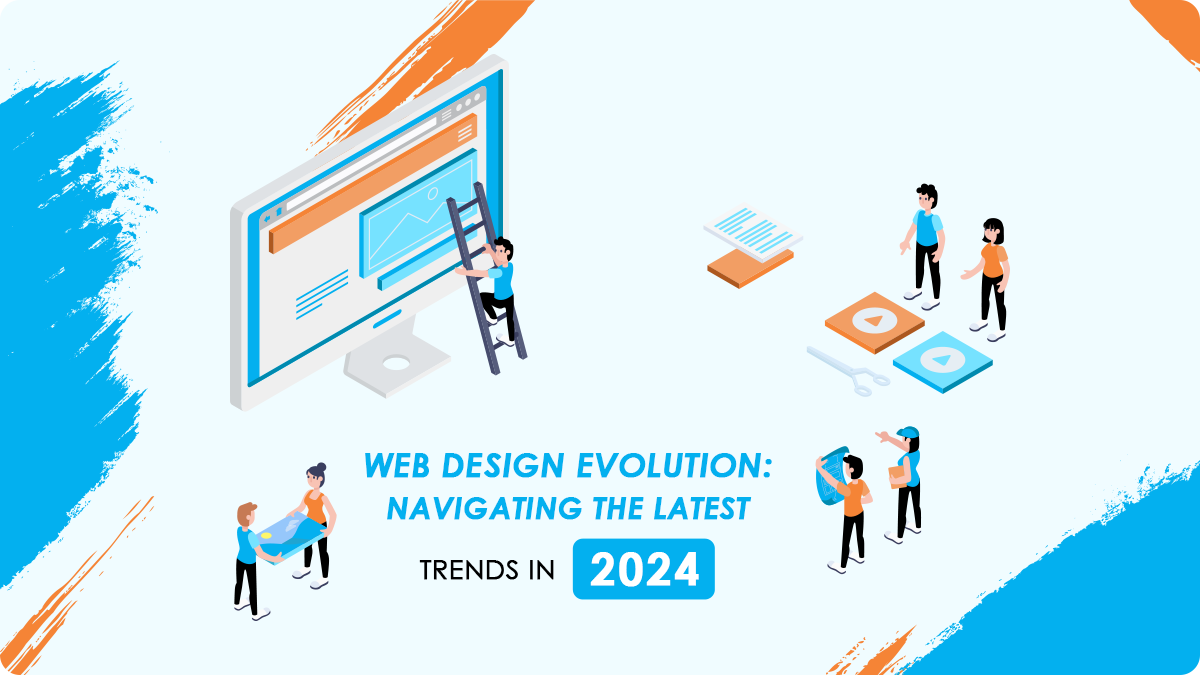In the swiftly advancing realm of technology, web design remains in a perpetual state of evolution. As we enter 2024, the arena of web design is witnessing ongoing transformative shifts, guided by advancements in technology, user expectations, and emerging design philosophies. It is imperative for web designers and businesses to adeptly navigate these contemporary trends to remain pertinent and provide outstanding user experiences. Let’s explore the pivotal trends that are molding the landscape of web design in 2024.

1. Dark Mode and Light Mode Options
Dark mode has gained immense popularity in recent years, providing users with an alternative color scheme that is easier on the eyes, especially in low-light environments. In 2024, web designers are not just embracing dark mode but also incorporating light mode options, allowing users to choose based on personal preferences. This flexibility caters to a diverse audience, enhancing accessibility and usability.
2. Immersive and Interactive Experiences
With the advent of powerful web technologies like WebGL and WebAssembly, designers are pushing the boundaries of interactivity. Websites are becoming more immersive, offering users engaging experiences beyond static content. Interactive storytelling, 3D graphics, and dynamic animations are becoming integral elements, creating a more engaging and memorable user journey.
3. AI and Machine Learning Integration
Artificial Intelligence (AI) and Machine Learning (ML) are not just buzzwords; they are shaping the way websites interact with users. In 2024, personalized user experiences are taking center stage. AI algorithms analyze user behavior, predict preferences, and dynamically adjust website content to cater to individual needs. The degree of personalization this offers improves customer pleasure and engagement.
4. Voice User Interface (VUI)
Voice technology continues to evolve, and VUI is making its mark in web design. With the rise of virtual assistants and smart speakers, users are becoming more accustomed to interacting with devices using their voice. Web designers are integrating voice commands and interfaces to create a seamless and hands-free browsing experience. This trend is particularly relevant for mobile devices and smart home applications.
5. Sustainability and Green Design
As environmental consciousness grows, web designers are incorporating sustainable and eco-friendly design practices. Optimizing website performance for energy efficiency, reducing carbon footprints, and utilizing renewable resources are becoming essential considerations in web development. Green design not only aligns with environmental values but also contributes to faster-loading websites and improved user experiences.
6. Minimalism with Micro-interactions
Minimalist design principles continue to dominate in 2024. Clean layouts, ample white space, and simple color schemes contribute to a visually pleasing and user-friendly interface. However, designers are adding a touch of sophistication with micro-interactions – subtle animations or effects that respond to user actions. These micro-interactions provide feedback, making the user experience more intuitive and engaging.
7. Augmented Reality (AR) and Virtual Reality (VR)
The integration of AR and VR technologies is reshaping the way users interact with websites. In 2024, businesses are leveraging AR for virtual try-ons, product visualization, and immersive storytelling. VR, on the other hand, is creating virtual environments for users to explore. Both technologies add a new dimension to web design, offering unique and captivating experiences.
8. Biometric Authentication
Security is a top priority, and web designers are increasingly turning to biometric authentication methods to enhance user protection. Facial recognition, fingerprint scanning, and other biometric identifiers are being seamlessly integrated into the user interface, providing a secure yet user-friendly authentication process. This trend is particularly prominent in e-commerce and financial websites.
9. Accessible and Inclusive Design
Web accessibility is not just a trend; it’s a fundamental aspect of ethical web design. In 2024, designers are prioritizing accessibility, ensuring that websites are usable by people of all abilities. This includes implementing features like text-to-speech, adjustable font sizes, and color-contrast adjustments. Inclusive design aims to create a web environment accessible to everyone, regardless of disabilities.
10. Progressive Web Apps (PWAs)
Progressive Web Apps are gaining traction as a hybrid approach that combines the best features of websites and mobile apps. In 2024, businesses are investing in PWAs to provide users with a seamless experience across devices. These apps offer offline functionality, push notifications, and faster loading times, blurring the lines between traditional websites and mobile applications.
Conclusion
To traverse the changing terrain of web design in 2024, designers and businesses must remain tuned in to these trends, crafting engaging, user-centered experiences. Whether it involves the surge of immersive technologies, the incorporation of AI, or a dedication to sustainability, the evolution in web design signifies a dedication to innovation and responsiveness to user requirements. By adopting these trends, web designers can not only keep pace with the latest developments but also play a role in shaping a digital landscape that is dynamic, accessible, and visually impressive.
